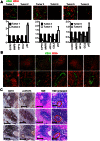B cells promote tumor progression via STAT3 regulated-angiogenesis
- PMID: 23734190
- PMCID: PMC3667024
- DOI: 10.1371/journal.pone.0064159
B cells promote tumor progression via STAT3 regulated-angiogenesis
Abstract
The role of B cells in cancer and the underlying mechanisms remain to be further explored. Here, we show that tumor-associated B cells with activated STAT3 contribute to tumor development by promoting tumor angiogenesis. B cells with or without Stat3 have opposite effects on tumor growth and tumor angiogenesis in both B16 melanoma and Lewis Lung Cancer mouse models. Ex vivo angiogenesis assays show that B cell-mediated tumor angiogenesis is mainly dependent on the induction of pro-angiogenic gene expression, which requires Stat3 signaling in B cells. Furthermore, B cells with activated STAT3 are mainly found in or near tumor vasculature and correlate significantly with overall STAT3 activity in human tumors. Moreover, the density of B cells in human tumor tissues correlates significantly with expression levels of several STAT3-downstream pro-angiogenic genes, as well as the degree of tumor angiogenesis. Together, these findings define a novel role of B cells in promoting tumor progression through angiogenesis and identify STAT3 in B cells as potential therapeutic target for anti-angiogenesis therapy.
Conflict of interest statement
Figures





References
-
- Pages F, Berger A, Camus M, Sanchez-Cabo F, Costes A, et al. (2005) Effector memory T cells, early metastasis, and survival in colorectal cancer. N Engl J Med 353: 2654–2666. - PubMed
-
- Galon J, Costes A, Sanchez-Cabo F, Kirilovsky A, Mlecnik B, et al. (2006) Type, density, and location of immune cells within human colorectal tumors predict clinical outcome. Science 313: 1960–1964. - PubMed
-
- Tan TT, Coussens LM (2007) Humoral immunity, inflammation and cancer. Curr Opin Immunol 19: 209–216. - PubMed
-
- Ohri CM, Shikotra A, Green RH, Waller DA, Bradding P (2009) Macrophages within NSCLC tumour islets are predominantly of a cytotoxic M1 phenotype associated with extended survival. Eur Respir J 33: 118–126. - PubMed
Publication types
MeSH terms
Substances
Grants and funding
LinkOut - more resources
Full Text Sources
Other Literature Sources
Miscellaneous

